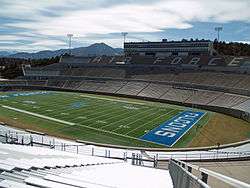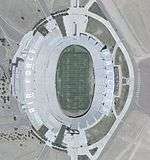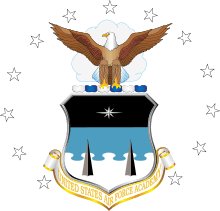Falcon Stadium
 From northeast corner in 2008 | |
| Location |
2169 Field House Drive U.S. Air Force Academy Colorado Springs, CO, U.S. |
|---|---|
| Coordinates | 38°59′49″N 104°50′35″W / 38.997°N 104.843°WCoordinates: 38°59′49″N 104°50′35″W / 38.997°N 104.843°W |
| Owner | U.S. Air Force |
| Operator | U.S. Air Force Academy |
| Capacity |
46,692 (2005–present) 52,480 (1996–2004) 50,126 (1995) 52,000 (1993–1994) 52,123 (1986–1992) 46,668 (1972–1985) 40,828 (1962–1971) |
| Record attendance |
56,409 (vs. Notre Dame, 2002) |
| Surface |
FieldTurf (2006–present) Natural grass (1962–2005) |
| Construction | |
| Opened |
September 22, 1962 56 years ago |
| Expanded | 1972, 1990 |
| Construction cost |
$3.5 million ($28.3 million in 2018[1] ) |
| Architect |
Praeger-Kavanaugh-Waterbury[2] Slater Paul Architects (renovations) |
| General contractor | B. H. Baker Inc.[2] |
| Tenants | |
|
Air Force Falcons (NCAA) (1962–present) | |

Stadium

Falcon Stadium is an outdoor football stadium in the western United States, located on the campus of the U.S. Air Force Academy in Colorado Springs, Colorado. It is the home field of the Air Force Falcons of the Mountain West Conference, and also holds the academy's graduation ceremonies each spring.[3][4]
History
From 1956 to 1961, Air Force played its home games at various sites along the Front Range in Colorado.[5][6] Most games were played in Denver at the University of Denver's stadium,[7] but several were played in Colorado Springs, Pueblo, and CU's Folsom Field in Boulder.[8]
Planned in 1955,[9][10] Falcon Stadium opened 56 years ago in 1962, at a cost of $3.5 million, and has a current seating capacity of 46,692. The first game was on September 22, a 34–0 victory over Colorado State.[11] It was officially dedicated four weeks later on October 20,[12][13] with a ceremony which included the Thunderbirds.[14]
Construction
The U.S. Air Force Academy lies at the base of the Rampart Range of the Rocky Mountains, northwest of adjacent Colorado Springs.[15] Built into a natural bowl about two miles (3 km) southeast and 500 feet (150 m) below the cadet area, Falcon Stadium is approximately a mile (1.6 km) west of Interstate 25.
With an unbalanced design and a traditional north-south alignment, the western sideline has the press box and two large grandstand tiers above the main bowl; the eastern side has a single tier, bordered by seven separate sections of grandstands.
Elevation
The FieldTurf playing field is at an elevation of 6,621 feet (2,018 m) above sea level,[16] the second highest in FBS college football, exceeded only by conference foe Wyoming's War Memorial Stadium in Laramie, which is 600 feet (180 m) higher.
The Walkup Skydome at FCS Northern Arizona in Flagstaff is also slightly higher, by 250 feet (75 m). In Division II, the Mountaineer Bowl of Western State Colorado in Gunnison exceeds them all at 7,769 feet (2,368 m).
Improvements
Falcon Stadium had a natural grass field for its first 44 years, although the sideline areas where teams stood were artificial turf since the 1980s. Prior to the 2006 season, synthetic FieldTurf was installed at a cost of $750,000.
The stadium has been expanded twice, and the 2005 renovation lowered the total seating capacity. Permanent lighting was installed in Falcon Stadium in 2002 at a cost of $500,000, and the video screen at the south end of the field debuted in 2004. A new sound system was also installed for the 2006 season. The scoreboard was removed after the 2015 season, and a new, larger video board measures 31 ft 2 in (9.5 m) tall by 82 ft 8 in (25.2 m) wide, with a total surface area of more than 2,500 square feet (230 m2). At its installation in 2016, it was the largest in the Mountain West Conference and amongst the service academies. A second video board was also installed behind the northeast stands prior to the 2016 season.
See also
References
- ↑ Federal Reserve Bank of Minneapolis Community Development Project. "Consumer Price Index (estimate) 1800–". Federal Reserve Bank of Minneapolis. Retrieved January 2, 2018.
- 1 2 Falcon Stadium, United States Air Force Academy, 6/30/2012
- ↑ "Nixon defends military in A.F. Academy speech". Lodi News-Sentinel. (California). UPI. June 5, 1969. p. 3.
- ↑ Hilliard, Carl (May 29, 1986). "Bush addresses Air Force class". Times-News. (Hendersonville, North Carolina). Associated Press. p. 21.
- ↑ cfbdatawarehouse.com, 1956 data Archived November 18, 2007, at the Wayback Machine.
- ↑ cfbdatawarehouse.com, 1960 data Archived November 18, 2007, at the Wayback Machine.
- ↑ "Army & Middies snubbing Falcons?". Spokesman-Review. (Spokane, Washington). Associated Press. October 14, 1958. p. 19.
- ↑ MacCambridge, Michael, ed. ESPN College Football Encyclopedia. New York: Hyperion, 2005. Pg. 68.
- ↑ "Plan stadium for Air Force football team". Ellensburg Daily Record. Washington. Associated Press. October 28, 1955. p. 8.
- ↑ "Air academy stadium planned in Colorado". Tuscaloosa News. (Alabama). Associated Press. October 30, 1955. p. 13.
- ↑ "Rockies: Air Force 34–0". Eugene Register-Guard. (Oregon). Associated Press. September 23, 1962. p. 5B.
- ↑ "Air Force will dedicate stadium". Florence Times. (Alabama). Associated Press. October 17, 1962. p. 2.
- ↑ "Ducks sail past airmen". Spokesman-Review. (Spokane, Washington). Associated Press. p. 2, sports.
- ↑ Strite, Dick (October 21, 1962). "Oregon shoots down Air Force 35-20". Eugene Register-Guard. (Oregon). p. 1B.
- ↑ Sutton, Horace (October 22, 1961). "Sky blue". Toledo Blade. (Ohio). (Sunday magazine). p. 28.
- ↑ Topographic map from USGS via Microsoft Research Maps
External links
- Air Force Academy Official Athletic Site
- Air Force Sports.com - Falcon Stadium - Fan Guide
- Sports-Venue.Info - Falcon Stadium information & photos
